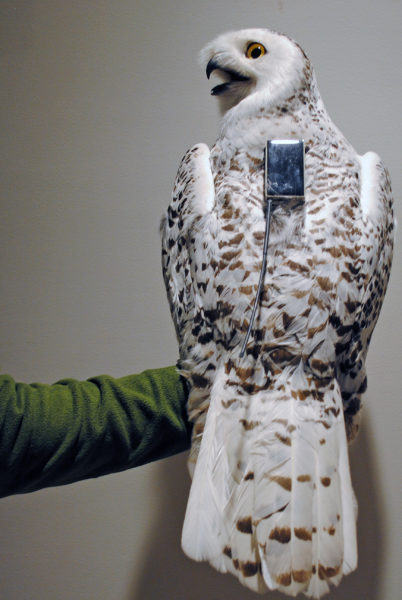
Amherst with her hybrid GSM/Argos transmitter, when she was tagged in 2020. (©Rebecca McCabe)
To our great sadness and disappointment, Amherst’s injuries were worse than we thought, and she did not make it.
As I explained in our last post Amherst, an adult female we tagged in February 2020, was found about six weeks ago on Simcoe Island, Ontario, (not on Amherst Island, as I originally thought) with what appeared to be a relatively minor wing injury. Simcoe residents Rachel Seal and her husband, who found her, carried her across an ice bridge between Simcoe and neighboring Wolfe Island. (The little three-car ferry that serves Simcoe doesn’t operate in winter.) From there, they caught a different ferry from Wolfe to the mainland at Kingston and then drove the owl to Sandy Pines Wildlife Centre in Napanee. This was seriously above and beyond the call of duty, and we’re very grateful to the Seals.
Sue Meech and her staff at Sandy Pines X-rayed Amherst and found a badly bruised area over the radius and ulna in the left wing, which didn’t really explain her reluctance to fly or her unwillingness to feed herself. With time, rest and pain meds, though, she seemed to be improving and after about 10 days was moved to a flight cage, where she was using higher and higher perches.
Then, disaster. Amherst was again unable to fly, and when she was examined it was found she had a dislocated elbow on that wing. Sue consulted (as she had been throughout the process) with Dr. Erica Miller from our SNOWstorm team, and Erica in turn reached out to a number of other wildlife veterinarians experienced with raptors. They all felt that, especially given the fast and highly aerobatic hunting style that snowy owls use (for example, chasing down waterfowl on the wing, almost like a falcon), the joint would simply never be stable enough for release.
Unfortunately, the joint also would quickly develop severe and untreatable arthritis, which would condemn Amherst to a lot of pain. The only alternative would be to amputate the entire wing, which they all felt would be too drastic a change for an adult bird that had lived a free-flying life for years.
Reluctantly, but we think correctly, they decided the only humane option was euthanasia. Amherst was sent to our colleague Dr. Guy Fitzgérald in Montréal for necropsy, which may shed more light on her original injury.
We’ve lost a number of owls over the years, including Aimé earlier this winter, but sharing this kind of news never gets any easier. But Amherst’s story does exemplify the lengths to which rehabber, veterinarians and average folks like the Seals will go to help wildlife. And the data we collected from Amherst, including her two breeding seasons in the North, are an important contribution to the growing body of science on snowy owl ecology.
We do have happier news on our other owls, most of which have begun their migrations north for the spring — more news on that this weekend.


8 Comments on “Sad News”
Thank you so very much for both the extraordinary efforts of the Seal’s and the medical experts in making the right choice for Amherst. We as humans reactivity think -Save the bird. Do whatever it takes! Stepping back and thinking of the bird and not what we want, it becomes clear what is best for the life of free flyer that would never be pain free or happy without the ability to soar and hunt again.
Thanks for the update Scott!
As someone who did raptor rehab myself many years ago, I know the hardest decision is often this one, and that what at first seems like mercy — “saving” the bird at any price — can just be our own selfishness in shying away from the tougher but ultimately more humane decision. I have enormous respect for the folks like Sue and her staff to climb into the trenches every day.
Forever in our hearts Amherst. Fly free.
So sorry. And so thankful to the couple that went through such great efforts to try to help her.
So sad that beautiful Amherst didn’t make it. Thanks to all that cared for her.
Always sad to hear of the loss of even one Snowy! Thank you for sharing and thanks to all those who added their time and talent to the care of such a beautiful being. Amherst will now be forever on our hearts and we will remember her with each SNOWstorm!
I am very sorry to hear that! I am always sorry and sad for any animal that dies. Thanks to all the people that helped take care of her! It is so sad to hear that. Thank you for sharing this blog post. I will definitely have Amherst in my forever heart! Let’s just hope that no more of these owls are lost!
I am a wildlife photographer and just last year started photographing Snowy Owls in the Flathead County of
Northwestern Montana. Though we have a few of these beautiful birds, they are the atraction of most birders who often travel hundreds of miles to photograph them. I am trying to get caught up on their lifestyle, habitat, migration patterns, and purposes for flying south and this is how I became aware of Cornell University Ornithology work and now Project SNOW Storm which I would like to follow more closely.
I really appreciate what I have read in the articles in this publication. Keep up the great work.